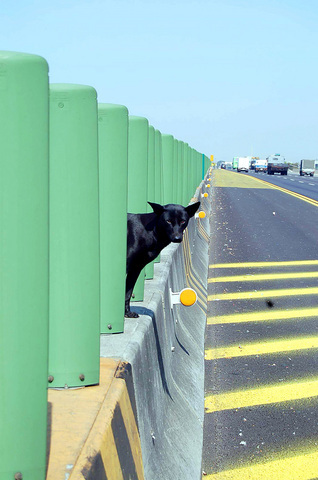Over two years ago, a black stray dog wandered onto the Sun Yat-sen Freeway and has lived ever since on the central island of the freeway, under bad conditions, perhaps because it dares not cross the busy road again.
The medium-sized dog lives on the central island between Changhua Interchange and Yuanlin Toll Station in central Taiwan.
The dog lives on food thrown at it by drivers. Since the place is located at the 209th kilometer of the freeway, local police have called the dog "209," while reporters at National Traffic Network of the Police radio station call it the "dog of Changhua."

PHOTO: YEN HUNG-CHUN, TAIPEI TIMES
"I bet it is the stray dog that has survived the longest on a freeway island," said a driver surnamed Yen (
Yen first noticed "209" on a rainy morning over two years ago and he saw it again at the same location the next day.
Nobody knows exactly where "209" is from.
Local police said that it usually lingers on the 1m-wide island between Changhua Interchange, located at the 200th kilometer of the freeway, and Yuanlin Toll Station, at the 216th kilometer of the freeway.
Numerous drivers called Police Radio Station to show their concern, and "209" became famous.
A woman surnamed Lai (
Lai said that she feels happy whenever she sees "209," because it is good to know that the dog is still alive. She hopes it will be leave the freeway someday, because a wide and beautiful world is waiting for it on the other side of the road, she said.
Local police said that "209" mostly waits for food around the 209th kilometer of the freeway between 7am and 9am when drivers go to work and between 4pm and 6pm when they go off work.
It is a miracle that "209" has survived under such difficult conditions, they added.
In response to the case, workers from Taichung Universal Animal Protection Association said they would provide necessary tools and assistance to local police to move "209" from the island.

Taiwan is to commence mass production of the Tien Kung (天弓, “Sky Bow”) III, IV and V missiles by the second quarter of this year if the legislature approves the government’s NT$1.25 trillion (US$39.78 billion) special defense budget, an official said yesterday. Commenting on condition of anonymity, a defense official with knowledge of the matter said that the advanced systems are expected to provide crucial capabilities against ballistic and cruise missiles for the proposed “T-Dome,” an advanced, multi-layered air defense network. The Tien Kung III is an air defense missile with a maximum interception altitude of 35km. The Tien Kung IV and V

The disruption of 941 flights in and out of Taiwan due to China’s large-scale military exercises was no accident, but rather the result of a “quasi-blockade” used to simulate creating the air and sea routes needed for an amphibious landing, a military expert said. The disruptions occurred on Tuesday and lasted about 10 hours as China conducted live-fire drills in the Taiwan Strait. The Civil Aviation Administration (CAA) said the exercises affected 857 international flights and 84 domestic flights, affecting more than 100,000 travelers. Su Tzu-yun (蘇紫雲), a research fellow at the government-sponsored Institute for National Defense and Security Research, said the air

Taiwan lacks effective and cost-efficient armaments to intercept rockets, making the planned “T-Dome” interception system necessary, two experts said on Tuesday. The concerns were raised after China’s military fired two waves of rockets during live-fire drills around Taiwan on Tuesday, part of two-day exercises code-named “Justice Mission 2025.” The first wave involved 17 rockets launched at 9am from Pingtan in China’s Fujian Province, according to Lieutenant General Hsieh Jih-sheng (謝日升) of the Office of the Deputy Chief of the General Staff for Intelligence at the Ministry of National Defense. Those rockets landed 70 nautical miles (129.6km) northeast of Keelung without flying over Taiwan,

City buses in Taipei and New Taipei City, as well as the Taipei MRT, would on Saturday begin accepting QR code payments from five electronic payment providers, the Taipei Department of Transportation said yesterday. The new option would allow passengers to use the “transportation QR code” feature from EasyWallet, iPass Money, iCash Pay, Jkopay or PXPay Plus. Passengers should open their preferred electronic payment app, select the “transportation code” — not the regular payment code — unlock it, and scan the code at ticket readers or gates, General Planning Division Director-General Liu Kuo-chu (劉國著) said. People should move through the